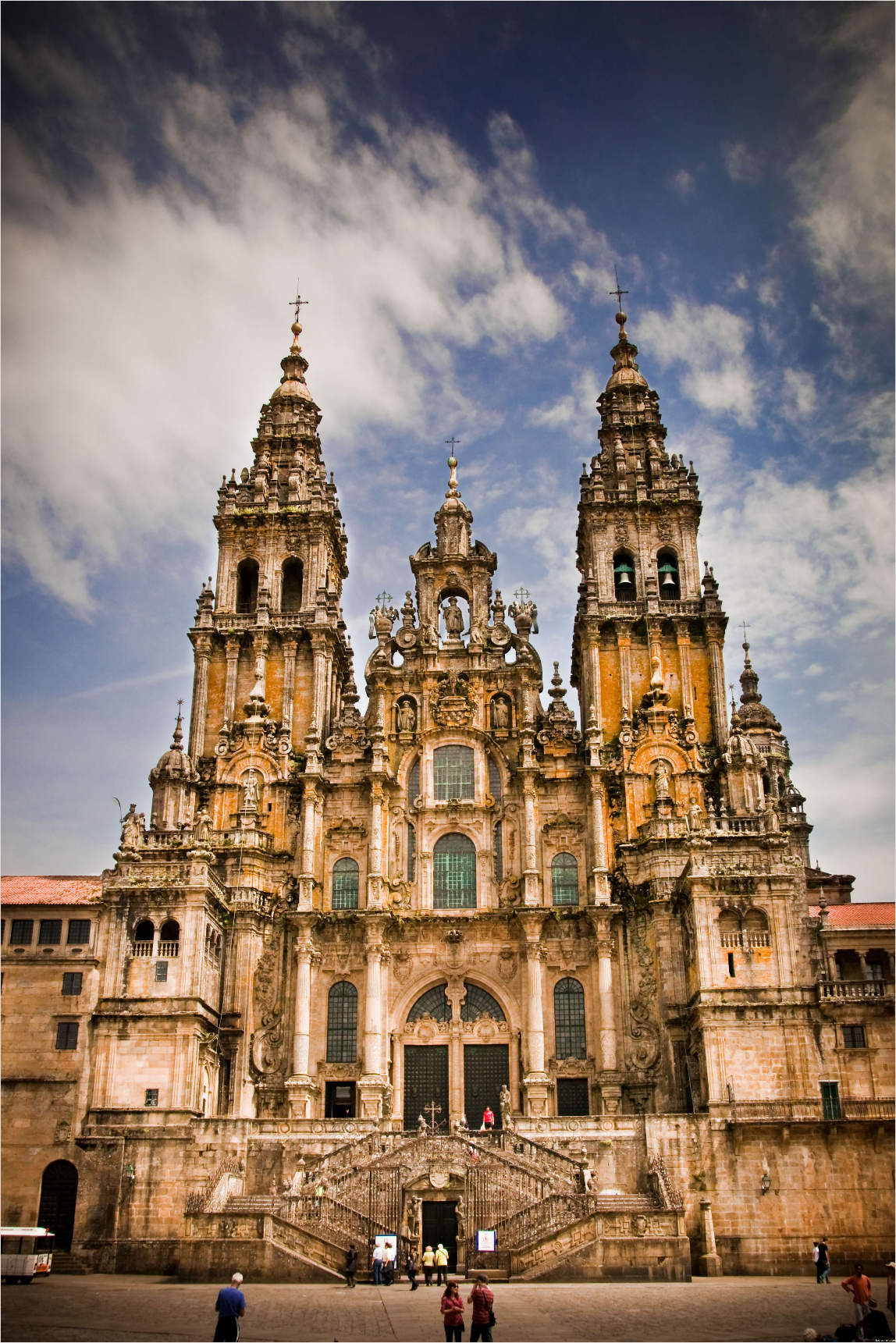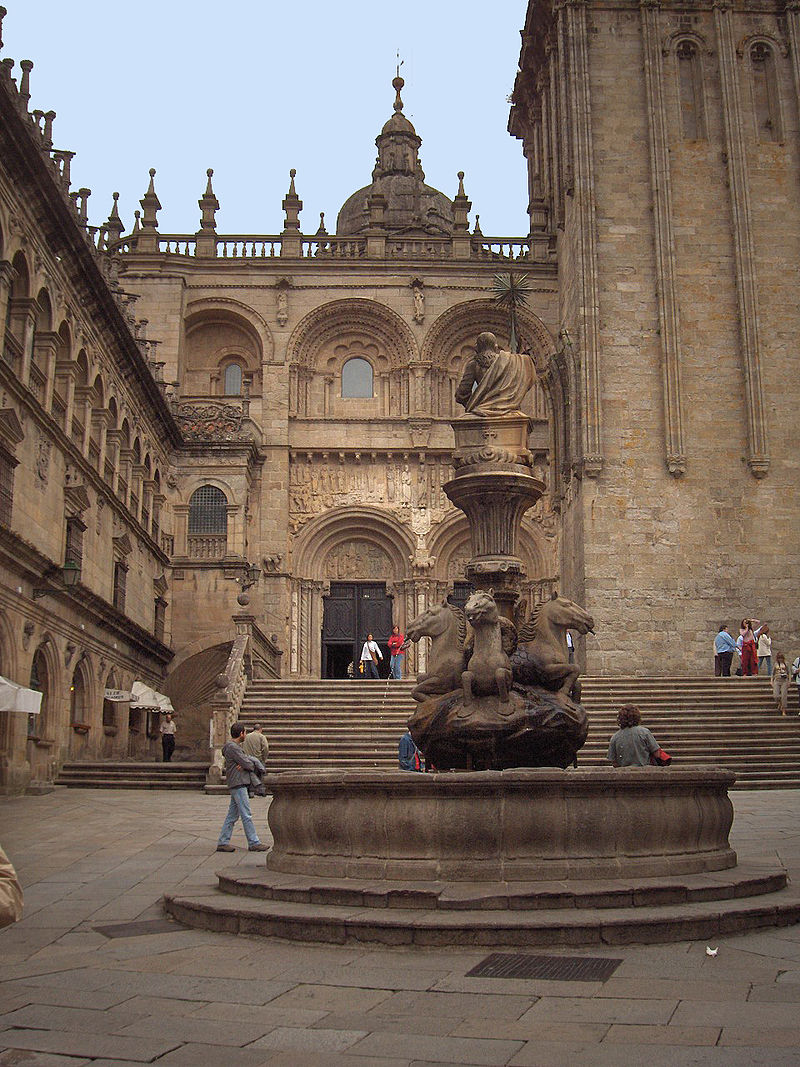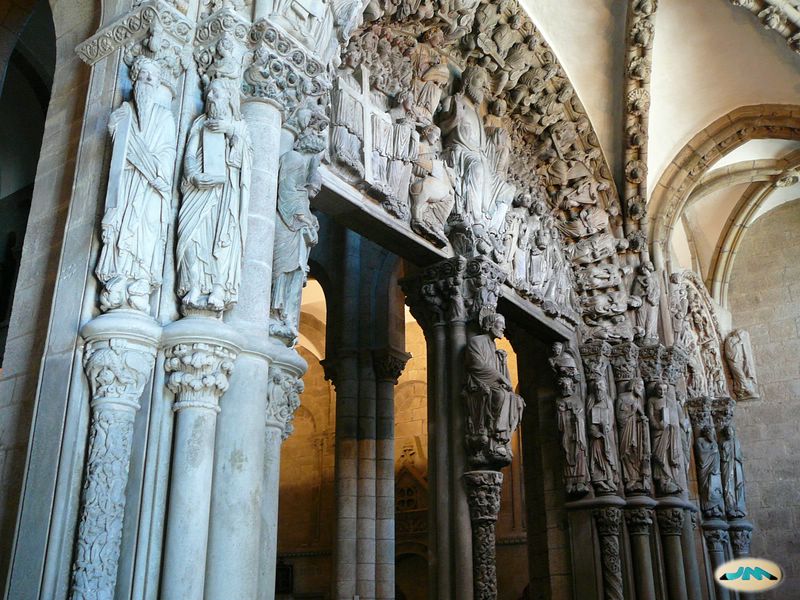
The Santiago de Compostela Cathedral is one of the most prominent works of European art of the 11th century. I have chosen to write about this cathedral, as it has a unique history and is of great significance to millions of people around the globe. The Portico of Glory, which is the cathedral’s main gate, is of particular interest to me, as it features almost all the typical characteristics of a Romanesque portico.
According to the legend of Saint James, the saint preached the gospel in Spain and was brought to Galicia to be buried there by his disciples after his martyrdom (“James the Great”, 2020). The second part of the cathedral’s name, Compostela, comes from Latin “Campus Stellae”, which means “the place marked by the star”. In 814 AD, hermit Pelagius saw strange lines in the sky at night and understood that it could be a miracle. This led him to rediscover the tomb of the apostle Saint James the Great. Bishop Theodomirus of Iria claimed that it was a miracle and informed King Alfonso II of it. A chapel was built on the site of the miracle, and the king is believed to be the first pilgrim.
The early church was built on the site in 829, followed by another one in 899. In 997, the church was completely destroyed by an army commander of the caliph of Córdoba (“Santiago de Compostela Cathedral”, 2020). By that time, the place had virtually become the second most popular pilgrimage site among Europeans. During the Reconquista, Spanish warriors often saw Saint James, and the apostle soon became the patron saint of Spain.
Alfonso VI ordered to building of the cathedral in the late 11th century. The plan of the brick church of Saint Sernin in Toulouse was used (“Santiago de Compostela Cathedral”, 2020). No wonder that both churches represent great examples of the beauty and grace of Romanesque architecture in their respective countries. Yet, the cathedral in Spain was mostly completed in granite. The construction process was not smooth and was finished only in 1122. However, it was completely furnished and decorated only several decades later. The cathedral was consecrated in 1211 (“Portico of Glory”, 2020). Several architects worked on the project, including Bernard the Elder, Bernard the Younger, and Galperinus.
It can be said that both the city and the cathedral were destined to be loved by people from what would become Spain and beyond and cherished by the church authorities and kings. The cathedral is built over the tomb of an apostle of Jesus, along with St. Peter’s Basilica in Vatican City and St. Thomas Cathedral Basilica, Chennai in India (“Santiago de Compostela Cathedral”, 2020). What is more, it was the final point of the Way of St. James (Camino de Santiago), which used to be an extremely popular pilgrim route. It is said that pilgrims used to carry stones from the quarries near Triacastela to the ovens of Castañeda to make the lime used in the construction of the Santiago de Compostela (Muller, 2010). The city itself grew rapidly due to the mass influx of pilgrims.
The Santiago de Compostela, in its original version, used to represent an almost pure standard of a Romanesque cathedral. It is huge and several chapels are attached to it. Its walls are thick as the rounded marble columns are. Massive rounded arches and an abundance of Romanesque sculptures are still easily identified as the heritage of Roman-style architecture. However, the abovementioned significance of the structure and the site itself led to generous donations, which directly influenced the way several façades look today.
Now the cathedral features numerous typically Baroque and Gothic alterations and decorations that, nevertheless, contribute to the grand impression it makes on millions of architects, scholars, tourists, and pilgrims. The way Gothic and Baroque elements coexist with the earlier Medieval structures is truly fascinating. Take, for example, the North Tower or da Carrara which seems to rival the earlier tower of the Romanesque period.
The interior of the Santiago de Compostela is generally Romanesque, with all the features that managed to survive to this day, such as the nave, a wide transept, two lateral aisles, and a choir with radiating chapels. The cathedral managed to preserve the barrel-vaulted, cruciform interior. To find the exclusively Romanesque parts of the structure, one should pay specific attention to two parts of the cathedral: the Pórtico da Gloria and the Pratarías façade.
The Pórtico da Gloria was created in the late 12th century. The construction was possible due to the annual donations of the king. The unique characteristic of the portal is the proportions the architect had to use. The portico was originally planned as a portal consisting of four parts. Nevertheless, Master Mateo understood that an extremely high and narrow portico would fit better and produce a much greater impression on the pilgrims entering the cathedral. It features three-round arches supported by piers with pilasters. The three-round arches symbolize the three naves of the church. The Pórtico da Gloria also includes a Last Judgement sculptural composition, which has some distinctive Gothic features (Encyclopaedia Britannica, 2016).
The central arch of the portico is divided in two by a huge mullion and has a tympanum. A depiction of Saint James, who sits in a chair supported by two lions and a pilgrim swagger stick in hand, can be found on the mullion. All the columns are virtually divided into several ones in the middle, all of the smaller columns decorated with the Romanesque statues of the Apostles. The jambs of the three doors are decorated with figures of apostles and prophets. Each of the statues depicts some of the characteristics of the person it represents. All the carved capitals are different, and the books that apostles and prophets hold in their hands feature their names. The Pórtico da Gloria is considered to be the greatest work of Spanish Romanesque sculpture by many scholars.
Only one façade of the structure maintains the original Romanesque style (Figure 2). It was built in the 12th century, although it also contains a few later additions. The tympanums feature a huge frieze emphasized by a strip that separates it from the upper body (Figure 3). There are also two typically Romanesque windows on that level. A statue of King David seating on his throne is located in the left abutment and represents a typical Romanesque artwork. Berenguela tower has images showing the creation of Eve, Christ on a throne, and The Binding of Isaac. Three of the columns are of white marble and the rest are of granite.


The status of the cathedral constantly changed as its importance and popularity among pilgrims helped to draw the attention of church authorities. The city itself finally became an archiepiscopal see and acquired its own university. Several decades ago, the city’s Old Town received a UNESCO World Heritage Site status. A great revival of the Way of Saint James happened in the 20th century, with more than 300,000 people now completing the last 100 km walk to Santiago de Compostela every year. The cathedral is of major importance for Spaniards and Catholics all around the world. Millions of people value it as both a sacred place and an outstanding work of art which features various styles and reflects the centuries-long history and culture of the country.
I have always been interested in the architecture of the Early Middle Ages and enjoyed the chance to analyze the history, the meaning, and the architecture of the cathedral. I believe that the Santiago de Compostela Cathedral is an example of harmony between various styles in a single artwork. The ability of architects to understand the history of a structure through careful analysis of different layers with such a variety of symbolic meanings fascinates me. I have changed my opinion about the structure, and now I understand the significance of the Santiago de Compostela Cathedral and Saint James for Spain and Spaniards. I believe that architecture can help people understand other generations and nations, as structures remain the main accessible primary source we have to enhance our knowledge of history and geography.
References
Encyclopaedia Britannica Inc. (2016). Santiago De Compostela. In Encyclopaedia Britannica. Web.
Muller, P., & Aranguiz A. F. (2010). Every pilgrim’s guide to walking to Santiago de Compostela. (L. Dennett, Trans.). Hymns Ancient and Modern Ltd.
Wikipedia Inc. (2020). James the Great.
Wikipedia Inc. (2020). Portico of Glory. Web.
Wikipedia Inc. (2020). Santiago de Compostela Cathedral. Web.